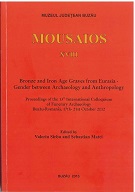Trade and trophy: near east imports in the Sarmatian culture
Trade and trophy: near east imports in the Sarmatian culture
Author(s): Oleksandr V. SymonenkoSubject(s): Archaeology
Published by: Muzeul Judetean Buzău
Keywords: Near East; Sarmatians; Egyptian; import; helmets; armour; silver bowls; jewellery; beads; glass vessels
Summary/Abstract: The objects, somehow related to the Near East, came to the Sarmatians in two main ways – as military trophies and as traded merchandise. Spoils of war were the helmets of Montefortino and Pilos types seized by Sarmatians in Asia Minor during the Mithridates wars. Another kind of trophies were the silver Parthian and Persian bowls and Achaemenid phialai with Parthian and Chorasmian inscriptions found in the graves of rich nomads in the Ural and Western Siberia regions. The possible route of their coming to Sarmatians was through Iran to Graeco-Bactria, robbed by Sarmatians in the late 2nd c. BC. Some specimens of jewellery, eye-decorated, trace-decorated and mosaic beads from Sarmatian graves were made in the Near East. The Egyptian origin can be determined for amulets of "Egyptian" faience in the shapes of scarabs, lions, frogs, amphorae, tiny altars, double cylinders. Some glass vessels from Sarmatian graves were made in the Near East: the moulded and cut Achaemenid calix, moulded glass kantharoi, millefiori vessels, faceted beaker of Eggers type 187 and some types of balsamarii, red-slip pottery of Eastern sigillata type.
Journal: Mousaios
- Issue Year: 2013
- Issue No: 18
- Page Range: 305-312
- Page Count: 8
- Language: English

